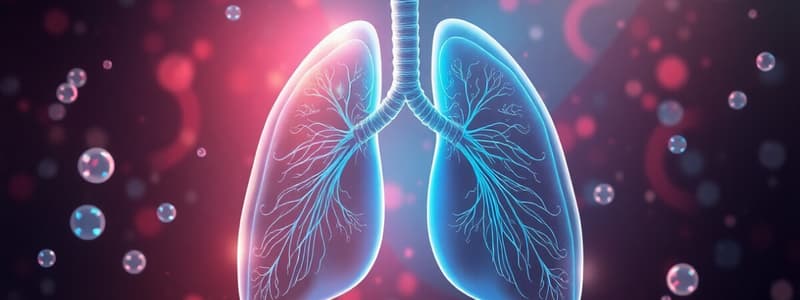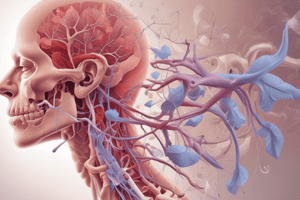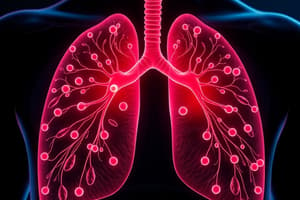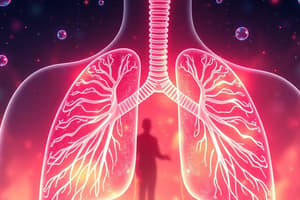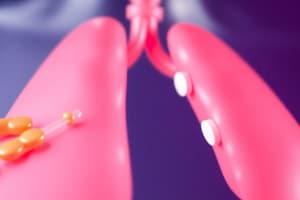Podcast
Questions and Answers
Which beta agonist has the shortest duration of action?
Which beta agonist has the shortest duration of action?
- Albuterol (correct)
- Indacaterol
- Salmeterol
- Fomoterol
What mechanism do inhaled anticholinergics primarily use to reduce smooth muscle contractility?
What mechanism do inhaled anticholinergics primarily use to reduce smooth muscle contractility?
- Inhibiting leukotriene synthesis
- Enhancing nitric oxide release
- Blocking muscarinic cholinergic receptors (correct)
- Stimulating cyclic AMP pathways
Which factor contributes to the side effects associated with beta 2 receptor agonists?
Which factor contributes to the side effects associated with beta 2 receptor agonists?
- Inherent activity on β1 receptors (correct)
- Non-selective binding to histamine receptors
- Their exclusive action on β1 receptors
- High absorption rates in the liver
What is a necessary precaution when using inhaled corticosteroids in children?
What is a necessary precaution when using inhaled corticosteroids in children?
Which medication class primarily inhibits the action of leukotrienes?
Which medication class primarily inhibits the action of leukotrienes?
Which inhaled corticosteroid is the most potent?
Which inhaled corticosteroid is the most potent?
What potential neurological effect is associated with leukotriene receptor agonists?
What potential neurological effect is associated with leukotriene receptor agonists?
Which drug is a first-generation antihistamine?
Which drug is a first-generation antihistamine?
Albuterol is primarily indicated for the treatment of which condition?
Albuterol is primarily indicated for the treatment of which condition?
What is a common side effect of methylxanthines like theophylline?
What is a common side effect of methylxanthines like theophylline?
Which of the following is true about oral decongestants?
Which of the following is true about oral decongestants?
What is the primary action of expectorants like guaifenesin?
What is the primary action of expectorants like guaifenesin?
Which of the following statements about nonopioid antitussives is correct?
Which of the following statements about nonopioid antitussives is correct?
Which class of diuretics is known for inhibiting sodium reabsorption in the ascending loop of Henle?
Which class of diuretics is known for inhibiting sodium reabsorption in the ascending loop of Henle?
What is a common side effect associated with diuretics that may lead to metabolic alkalosis?
What is a common side effect associated with diuretics that may lead to metabolic alkalosis?
Which laxative stimulates peristalsis through irritation of intestinal smooth muscle?
Which laxative stimulates peristalsis through irritation of intestinal smooth muscle?
What is an important precaution when using osmotic laxatives?
What is an important precaution when using osmotic laxatives?
Which side effect is NOT commonly associated with bulk-producing laxatives?
Which side effect is NOT commonly associated with bulk-producing laxatives?
What potential adverse effect is associated with the long-term use of aldosterone antagonists?
What potential adverse effect is associated with the long-term use of aldosterone antagonists?
What is a common contraindication for stimulant laxatives?
What is a common contraindication for stimulant laxatives?
What is the primary action of absorbent antidiarrheal drugs like kaolin and pectin?
What is the primary action of absorbent antidiarrheal drugs like kaolin and pectin?
Which diuretics are most likely to cause glucose intolerance?
Which diuretics are most likely to cause glucose intolerance?
What is a key precaution when prescribing laxatives for patients with known bowel obstruction?
What is a key precaution when prescribing laxatives for patients with known bowel obstruction?
What is the primary action of histamine-2 receptor antagonists (H2RAs) on gastric parietal cells?
What is the primary action of histamine-2 receptor antagonists (H2RAs) on gastric parietal cells?
Which opioid receptor antagonist is used to alleviate chronic constipation caused by opioid use?
Which opioid receptor antagonist is used to alleviate chronic constipation caused by opioid use?
Which laxative class is primarily recommended for softening obstipated stool?
Which laxative class is primarily recommended for softening obstipated stool?
Which drug is most potent at lowering gastric acid secretion among H2RAs, and what is unclear regarding its clinical benefit?
Which drug is most potent at lowering gastric acid secretion among H2RAs, and what is unclear regarding its clinical benefit?
What is a significant consequence of long-term laxative abuse?
What is a significant consequence of long-term laxative abuse?
Which of the following is a common adverse effect associated with cimetidine?
Which of the following is a common adverse effect associated with cimetidine?
For which patient demographic should the use of H2RAs be avoided due to potential cognitive adverse effects?
For which patient demographic should the use of H2RAs be avoided due to potential cognitive adverse effects?
Which of the following adverse effects is categorized under hematologic for H2RAs?
Which of the following adverse effects is categorized under hematologic for H2RAs?
What is a key reason for avoiding the use of H2RAs in pregnancy?
What is a key reason for avoiding the use of H2RAs in pregnancy?
What is the role of metoclopramide in the treatment of gastroesophageal reflux disease (GERD)?
What is the role of metoclopramide in the treatment of gastroesophageal reflux disease (GERD)?
Which is a goal of therapy for peptic ulcer disease (PUD)?
Which is a goal of therapy for peptic ulcer disease (PUD)?
What notable effect does long-term use of H2RAs have on vitamin levels?
What notable effect does long-term use of H2RAs have on vitamin levels?
Which drug class is generally preferred over H2RAs for gastric acid suppression in gastroesophageal reflux disease (GERD)?
Which drug class is generally preferred over H2RAs for gastric acid suppression in gastroesophageal reflux disease (GERD)?
What is a notable adverse effect of loperamide?
What is a notable adverse effect of loperamide?
Which of the following drugs is contraindicated in patients with Parkinson disease?
Which of the following drugs is contraindicated in patients with Parkinson disease?
What effect do antihistamines have on gastrointestinal secretions?
What effect do antihistamines have on gastrointestinal secretions?
Which population is particularly at risk for unexpected agitation from antihistamines?
Which population is particularly at risk for unexpected agitation from antihistamines?
What is the mechanism of action of Eluxadoline?
What is the mechanism of action of Eluxadoline?
Which adverse effect is associated with the use of cannabinoids in nausea and vomiting treatment?
Which adverse effect is associated with the use of cannabinoids in nausea and vomiting treatment?
What is a common risk associated with the long-term use of phenothiazines?
What is a common risk associated with the long-term use of phenothiazines?
What condition should scopolamine be avoided in due to its anticholinergic effects?
What condition should scopolamine be avoided in due to its anticholinergic effects?
Why should serotonin 5-HT3 receptor antagonists be used with caution in patients with ileus?
Why should serotonin 5-HT3 receptor antagonists be used with caution in patients with ileus?
Which of the following is an adverse effect of substance P/neurokinin 1 receptor antagonists?
Which of the following is an adverse effect of substance P/neurokinin 1 receptor antagonists?
What is a critical consideration when using diphenoxylate and difenoxin in pediatric patients?
What is a critical consideration when using diphenoxylate and difenoxin in pediatric patients?
What type of drug interaction should be monitored with substance P/neurokinin 1 receptor antagonists?
What type of drug interaction should be monitored with substance P/neurokinin 1 receptor antagonists?
What should be evaluated before administering sedative-hypnotics to older patients?
What should be evaluated before administering sedative-hypnotics to older patients?
What is one of the primary goals of GERD therapy?
What is one of the primary goals of GERD therapy?
Which nonpharmacologic intervention is recommended to help manage GERD symptoms?
Which nonpharmacologic intervention is recommended to help manage GERD symptoms?
Which of the following medications is considered first-line therapy for frequent GERD symptoms?
Which of the following medications is considered first-line therapy for frequent GERD symptoms?
What is a common adverse effect associated with the use of aluminum-based antacids?
What is a common adverse effect associated with the use of aluminum-based antacids?
Why are prokinetic agents reserved for use after maximum acid suppression therapy?
Why are prokinetic agents reserved for use after maximum acid suppression therapy?
What effect do proton pump inhibitors (PPIs) have on gastric acid secretion?
What effect do proton pump inhibitors (PPIs) have on gastric acid secretion?
What important consideration should be noted when using proton pump inhibitors?
What important consideration should be noted when using proton pump inhibitors?
Which statement about histamine-2 receptor antagonists (H2RAs) is accurate?
Which statement about histamine-2 receptor antagonists (H2RAs) is accurate?
What potential risk is associated with the long-term use of proton pump inhibitors?
What potential risk is associated with the long-term use of proton pump inhibitors?
Which antacid formulation is contraindicated in patients with hypercalcemia?
Which antacid formulation is contraindicated in patients with hypercalcemia?
What lifestyle modification is recommended to help decrease GERD symptoms?
What lifestyle modification is recommended to help decrease GERD symptoms?
What is the action of antacids when they interact with hydrochloric acid (HCl)?
What is the action of antacids when they interact with hydrochloric acid (HCl)?
What should a patient be cautioned about regarding the use of antacids?
What should a patient be cautioned about regarding the use of antacids?
What is a significant risk of using magnesium-based antacids in patients with renal failure?
What is a significant risk of using magnesium-based antacids in patients with renal failure?
Flashcards
Expectorants
Expectorants
Medicines that help to loosen mucus in the airways so it can be coughed up more easily.
Diuretics
Diuretics
A class of drugs that increase urine output by reducing sodium and water reabsorption in the kidneys.
How do Beta 2 Receptor Agonists work?
How do Beta 2 Receptor Agonists work?
Beta 2 Receptor Agonists bind to β2 smooth muscle cells in the airway. They stimulate smooth muscle cell relaxation, causing bronchodilation via the cyclic AMP pathway. They inhibit release of hypersensitivity mediators.
Loop Diuretics
Loop Diuretics
Signup and view all the flashcards
What are some examples of SABAs?
What are some examples of SABAs?
Signup and view all the flashcards
Thiazide Diuretics
Thiazide Diuretics
Signup and view all the flashcards
What are some examples of LABAs?
What are some examples of LABAs?
Signup and view all the flashcards
Aldosterone Antagonists
Aldosterone Antagonists
Signup and view all the flashcards
What are some examples of ULABAs?
What are some examples of ULABAs?
Signup and view all the flashcards
Stimulant Laxatives
Stimulant Laxatives
Signup and view all the flashcards
Osmotic Laxatives
Osmotic Laxatives
Signup and view all the flashcards
How do Inhaled Anticholinergics work?
How do Inhaled Anticholinergics work?
Signup and view all the flashcards
What are some examples of SAMAs?
What are some examples of SAMAs?
Signup and view all the flashcards
Bulk-Producing Laxatives
Bulk-Producing Laxatives
Signup and view all the flashcards
Lubricant Laxatives
Lubricant Laxatives
Signup and view all the flashcards
What are some examples of LAMAs?
What are some examples of LAMAs?
Signup and view all the flashcards
Surfactant Laxatives
Surfactant Laxatives
Signup and view all the flashcards
How does Glycopyrronium bromide work?
How does Glycopyrronium bromide work?
Signup and view all the flashcards
How do Methylxanthines work?
How do Methylxanthines work?
Signup and view all the flashcards
Hyperosmolar Laxatives
Hyperosmolar Laxatives
Signup and view all the flashcards
How do Inhaled Corticosteroids work?
How do Inhaled Corticosteroids work?
Signup and view all the flashcards
Chloride Channel Activator Laxatives
Chloride Channel Activator Laxatives
Signup and view all the flashcards
What are some characteristics of Inhaled Corticosteroids?
What are some characteristics of Inhaled Corticosteroids?
Signup and view all the flashcards
Opioid Receptor Antagonist Laxatives
Opioid Receptor Antagonist Laxatives
Signup and view all the flashcards
How do Leukotriene Modifiers work?
How do Leukotriene Modifiers work?
Signup and view all the flashcards
Absorbent Antidiarrheals
Absorbent Antidiarrheals
Signup and view all the flashcards
Opiate Antidiarrheals
Opiate Antidiarrheals
Signup and view all the flashcards
How do Antihistamines work?
How do Antihistamines work?
Signup and view all the flashcards
What are examples of first-generation antihistamines?
What are examples of first-generation antihistamines?
Signup and view all the flashcards
What are examples of second-generation antihistamines?
What are examples of second-generation antihistamines?
Signup and view all the flashcards
How do H2RAs work?
How do H2RAs work?
Signup and view all the flashcards
What are the side effects of Cimetidine?
What are the side effects of Cimetidine?
Signup and view all the flashcards
How do H2RAs affect gastric function?
How do H2RAs affect gastric function?
Signup and view all the flashcards
What are important considerations for H2RA use?
What are important considerations for H2RA use?
Signup and view all the flashcards
What is Metoclopramide used for?
What is Metoclopramide used for?
Signup and view all the flashcards
What is Bethanechol used for?
What is Bethanechol used for?
Signup and view all the flashcards
How do antacids help with GERD?
How do antacids help with GERD?
Signup and view all the flashcards
Why are PPIs preferred for PUD?
Why are PPIs preferred for PUD?
Signup and view all the flashcards
What are the goals of PUD treatment?
What are the goals of PUD treatment?
Signup and view all the flashcards
What are the long-term goals of PUD treatment?
What are the long-term goals of PUD treatment?
Signup and view all the flashcards
Loperamide: What is it?
Loperamide: What is it?
Signup and view all the flashcards
Eluxadoline: What is it?
Eluxadoline: What is it?
Signup and view all the flashcards
Alosetron: What is it?
Alosetron: What is it?
Signup and view all the flashcards
Antiemetics: What are they?
Antiemetics: What are they?
Signup and view all the flashcards
Antihistamines as Antiemetics: What are they?
Antihistamines as Antiemetics: What are they?
Signup and view all the flashcards
Phenothiazines: How do they work?
Phenothiazines: How do they work?
Signup and view all the flashcards
Cannabinoids: When are they used?
Cannabinoids: When are they used?
Signup and view all the flashcards
5-HT3 Receptor Antagonists: How do they work?
5-HT3 Receptor Antagonists: How do they work?
Signup and view all the flashcards
Anticholinergics: What are they and how do they work?
Anticholinergics: What are they and how do they work?
Signup and view all the flashcards
Substance P/neurokinin 1 (NK1) Receptor Antagonist: Why used?
Substance P/neurokinin 1 (NK1) Receptor Antagonist: Why used?
Signup and view all the flashcards
Trimethobenzamide: What is it?
Trimethobenzamide: What is it?
Signup and view all the flashcards
Gastrointestinal Drug Pharmacology: Overview
Gastrointestinal Drug Pharmacology: Overview
Signup and view all the flashcards
Diphenoxylate and Difenoxin: What are they?
Diphenoxylate and Difenoxin: What are they?
Signup and view all the flashcards
Antidiarrheals and Intestinal Infections: Why avoid?
Antidiarrheals and Intestinal Infections: Why avoid?
Signup and view all the flashcards
Phenothiazines: What are their potential side effects?
Phenothiazines: What are their potential side effects?
Signup and view all the flashcards
What are the goals of GERD therapy?
What are the goals of GERD therapy?
Signup and view all the flashcards
List some nonpharmacologic therapies for GERD.
List some nonpharmacologic therapies for GERD.
Signup and view all the flashcards
What are antacids used for and how do they work?
What are antacids used for and how do they work?
Signup and view all the flashcards
What are PPIs and when are they used for GERD?
What are PPIs and when are they used for GERD?
Signup and view all the flashcards
What are H2RAs and how do they work?
What are H2RAs and how do they work?
Signup and view all the flashcards
What are drugs that improve LES tone used for?
What are drugs that improve LES tone used for?
Signup and view all the flashcards
When are prokinetic agents used for GERD?
When are prokinetic agents used for GERD?
Signup and view all the flashcards
What are cytoprotective agents used for?
What are cytoprotective agents used for?
Signup and view all the flashcards
What are some common side effects of antacids?
What are some common side effects of antacids?
Signup and view all the flashcards
What are some important things to remember about using antacids?
What are some important things to remember about using antacids?
Signup and view all the flashcards
How do PPIs work and what are some potential side effects?
How do PPIs work and what are some potential side effects?
Signup and view all the flashcards
What are some potential long-term risks associated with PPI use?
What are some potential long-term risks associated with PPI use?
Signup and view all the flashcards
What are some precautions to take when using PPIs?
What are some precautions to take when using PPIs?
Signup and view all the flashcards
What is important to consider when managing GERD with PPIs?
What is important to consider when managing GERD with PPIs?
Signup and view all the flashcards
What are H2RAs used for and what is important to know about ranitidine?
What are H2RAs used for and what is important to know about ranitidine?
Signup and view all the flashcards
Study Notes
Beta 2 Receptor Agonists
- Bind to β2 smooth muscle cells in the airway, causing bronchodilation via cyclic AMP pathway.
- Inhibit release of hypersensitivity mediators, especially from mast cells.
- Have some β1 receptor activity, leading to side effects.
- Absorbed from the bronchi, metabolized in the liver, and excreted in the urine.
- Multiple forms and delivery systems.
- Side effects include tachycardia and tremors.
- Precautions include monitoring in patients with arrhythmias, cardiovascular disease, and hyperthyroidism.
Short-Acting Beta Agonists (SABA)
- Duration: 4-6 hours.
- Examples: Albuterol (Proair, Ventolin, Proventil), Levalbuterol (Xopenex), Pirbuterol (Maxair), and Tirbutaline (Brethine).
Long-Acting Beta Agonists (LABA)
- Duration: 12 hours.
- Examples: Salmeterol (Serevent), Formoterol (Foradil), and Arformoterol (Brovana).
Ultra-Long Acting Beta Agonists (ULABA)
- Duration: 24 hours.
- Examples: Indacaterol (Arcapta Neohaler), Olodaterol (Striverdi Respimat), and Vilanterol (Breo Ellipta).
Inhaled Anticholinergics
- Block muscarinic cholinergic receptors, antagonizing acetylcholine, which decreases cyclic GMP formation.
- Decreases smooth muscle contractility of the lungs.
- Poorly absorbed from the lungs and GI tract; 90% excreted in feces.
- 10% of the dose is metabolized, largely via hydrolysis.
- Side effects include dry mouth, cough, and headache.
- Precautions include avoiding in patients with urinary retention, BPH, or closed-angle glaucoma.
Inhaled Corticosteroids
- Inhibit IgE and mast cell mediated migration of inflammatory cells into the bronchial mucosa.
- Inhibit late-phase allergic reactions.
- Rapidly absorbed from lungs and GI.
- Less than one-fourth of the dose is deposited in the lungs.
- Swallowed portion extensively metabolizes first pass.
- Excreted in urine and feces.
- Multiple forms and delivery systems.
- Side effects include xerostomia, hoarseness, mouth irritation, dysgeusia, and oral candidiasis.
- Precautions include HPA suppression, high-dose ICS in children inhibiting growth, and contraindication in status asthmaticus.
- Highest potency: Fluticasone furoate DPI (Arnuity Ellipta).
- Lowest potency: Budesonide DPI (Pulmicort Flexhaler).
Leukotriene Modifiers
- Leukotrienes are inflammatory mediators produced by eosinophils and mast cells, leading to bronchospasm, airway hyperresponsiveness, and vascular leakage.
- Montelukast (Singulair) inhibits the cysteinyl leukotriene receptor.
- Zileuton (Zyflo) inhibits 5-lipoxygenase.
- Metabolized in the liver, with excretion in urine.
- Side effects include headache, sore throat (montelukast) and dyspepsia (zileuton).
- Precautions/contraindications include neuropsychiatric events.
Antihistamines
- Block histamine action at H1 receptors.
- Decrease respiratory, vascular, and GI smooth muscle constriction.
- Decrease capillary permeability.
- First-generation: non-selective central H1 receptors (e.g., diphenhydramine).
- Second-generation: selective peripheral H1 receptors (e.g., cetirizine).
- Well absorbed orally, metabolized in the liver and excreted in urine.
- Side effects include sedation, dry mouth, blurred vision, tremors.
- Precautions include first generation on Beer's Criteria list, paradoxical CNS stimulation in young children, and contraindication in newborns, premature infants, BPH, and narrow-angle glaucoma.
Antitussives
- Codeine: acts at cough centers, widely distributed, unknown metabolism/excretion.
- Dextromethorphan: codeine analog acts at medulla to increase cough threshold; metabolized, excreted.
- Benzonatate: anesthetic, acts on cough receptors; unknown metabolism/excretion.
- Side effects: drowsiness, dizziness, nausea.
- Precautions: respiratory disease.
- Considerations for chronic coughs.
Expectorants
- Guaifenesin: reduces viscosity of thick sputum, only FDA-approved expectorant.
- Thick bronchial secretions are composed of mucins produced by goblet cells.
- Guaifenesin decreases mucin production and stimulates vagal afferent nerves → increases hydration → more effective mucociliary clearance.
- Side effects: GI upset (nausea, vomiting, and diarrhea).
Diuretics
- First-line therapy in HTN and heart failure.
- Increased sodium and water retention leads to increased ECF volume.
- Diuretics reduce cardiac output and decrease peripheral resistance.
- Several classes include carbonic anhydrase inhibitors, osmotic diuretics, aldosterone antagonists, loop diuretics, and thiazides.
- Side effects include electrolyte imbalances (hypokalemia, hypercalcemia, hyponatremia, hypomagnesemia), hyperkalemia from some potassium-sparing diuretics, and elevated uric acid, glucose intolerance.
- Precautions include drug-drug interactions.
Laxatives
-
Stimulants: cascara, senna, bisacodyl, castor oil.
-
Osmotics: magnesium hydroxide, magnesium citrate, sodium phosphate, and polyethylene glycol 3350 (PEG 3350).
-
Lubricants: mineral oil.
-
Bulk-producing: psyllium, methylcellulose, polycarbophil.
-
Surfactants: docusate.
-
Hyperosmolar: glycerin, lactulose.
-
Chloride channel activators: lubiprostone, glycopyrronium bromide.
-
Abuse potential and dependency are potential issues, especially for stimulant laxatives
-
Conditions when laxatives are contraindicated include nausea and vomiting, and abdominal pain, especially if bowel obstruction is suspected.
-
Some drugs produce diarrhea and flatulence.
-
Some have potential for abuse.
Miscellaneous Drugs
- Others include olopatadine for nasal congestion, decongestants, and antidiarrheals.
- Specific information on each drug should be sought for particular drug applications.
Studying That Suits You
Use AI to generate personalized quizzes and flashcards to suit your learning preferences.
